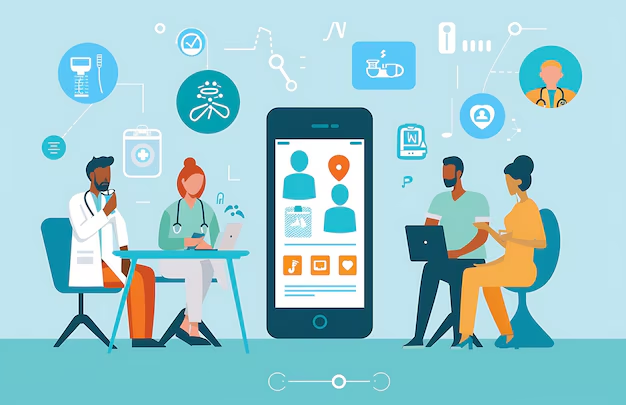In recent years, the healthcare landscape has undergone a significant transformation, largely driven by advancements in technology. Among these advancements, wireless networking has emerged as a pivotal force, enabling seamless communication and connectivity across various healthcare settings.
As the demand for efficient, accessible, and patient-centered care continues to rise, wireless networking technologies play a crucial role in facilitating telemedicine and remote monitoring solutions.
Telemedicine, the delivery of healthcare services through digital communication technologies, has revolutionized the way patients interact with healthcare providers. It has become an essential tool for enhancing access to medical expertise, particularly for individuals residing in remote or underserved areas.
Moreover, remote monitoring technologies empower patients to manage their health from the comfort of their homes, promoting proactive care and timely interventions.
This outline delves into the intricate relationship between wireless networking and healthcare, exploring how these technologies enable telemedicine and remote monitoring.
It will highlight the benefits, challenges, and future trends in this rapidly evolving field, illustrating how wireless networking is not only transforming healthcare delivery but also improving patient outcomes and experiences.
As we navigate this digital era, understanding the potential of wireless networking in healthcare is paramount for stakeholders seeking to optimize care delivery and enhance patient engagement.

Role of Wireless Networking in Healthcare Settings
Wireless networking has fundamentally changed the way healthcare services are delivered, fostering innovation and improving patient outcomes. Its role in healthcare settings can be summarized as follows:
- Enhanced Communication: Wireless networks facilitate real-time communication between healthcare professionals, patients, and administrative staff. This instant connectivity allows for quick decision-making, improved collaboration among care teams, and timely updates on patient status.
- Remote Access to Patient Data: Healthcare providers can access patient records, lab results, and imaging studies from virtually anywhere within a facility or even remotely. This accessibility supports informed decision-making and efficient patient management.
- Telemedicine Facilitation: Wireless networking is the backbone of telemedicine services, enabling video consultations, remote diagnostics, and follow-up care. Patients can connect with their healthcare providers without needing to travel, leading to increased convenience and reduced healthcare costs.
- Support for Wearable Devices: The rise of wearable health technologies, such as fitness trackers and medical devices, relies heavily on wireless networks for data transmission. These devices continuously monitor vital signs and other health metrics, sending real-time data to healthcare providers for analysis and intervention.
- Streamlined Operations: Wireless networks enhance operational efficiency by supporting various administrative functions, such as appointment scheduling, billing, and inventory management. This streamlining reduces administrative burdens and allows healthcare staff to focus more on patient care.
- Improved Patient Engagement: Wireless networking empowers patients to take an active role in managing their health. Through mobile health applications and patient portals, individuals can access educational resources, schedule appointments, and monitor their health data, fostering a more engaged patient population.
- Increased Flexibility and Mobility: Wireless networking allows healthcare professionals to move freely within healthcare settings while maintaining access to essential information. This mobility is particularly beneficial in dynamic environments like hospitals, where staff can provide care more efficiently.
Key Components of Wireless Healthcare Networks
Wireless healthcare networks consist of various components that work together to create a cohesive and effective system. The key components include:
- Wireless Access Points (WAPs): These devices connect wireless devices to the network, enabling communication within healthcare facilities. WAPs help extend coverage, ensuring that staff and patients can access network services throughout the premises.
- Mobile Devices: Smartphones, tablets, and laptops are integral to wireless healthcare networks, providing healthcare professionals with the tools needed to access patient information, communicate with colleagues, and conduct telemedicine visits.
- Wearable Health Devices: Devices such as smartwatches, heart rate monitors, and glucose sensors collect health data and transmit it wirelessly to healthcare providers. This real-time monitoring supports proactive healthcare management.
- Cloud Computing Services: Cloud infrastructure allows healthcare organizations to store and analyze vast amounts of patient data securely. It provides scalable resources for applications such as electronic health records (EHRs), enabling remote access to patient information.
- Network Security Solutions: Ensuring the security of sensitive patient data is paramount in healthcare. Firewalls, encryption technologies, and secure access protocols are essential components that protect against unauthorized access and data breaches.
- Internet of Things (IoT) Devices: IoT technologies, including smart medical equipment and environmental sensors, play a significant role in wireless healthcare networks. These devices collect and transmit data to enhance patient monitoring and operational efficiency.
- Healthcare Management Software: Applications designed for healthcare management facilitate scheduling, billing, and reporting, all accessible through wireless networks. These software solutions streamline administrative tasks and improve overall productivity.
Challenges in Wireless Networking for Healthcare
While wireless networking offers numerous advantages to the healthcare sector, it also presents several challenges that must be addressed to ensure effective implementation and operation. These challenges include:
- Security and Privacy Concerns:
- Data Breaches: Healthcare data is highly sensitive, making it a prime target for cyberattacks. Wireless networks can be more vulnerable to hacking attempts, leading to unauthorized access to patient information.
- Compliance Issues: Healthcare organizations must comply with regulations such as HIPAA (Health Insurance Portability and Accountability Act) in the U.S., which mandates strict protocols for protecting patient data. Ensuring compliance while using wireless networks can be complex and challenging.
- Network Reliability and Coverage Issues:
- Signal Interference: Wireless signals can be affected by physical obstacles, such as walls and medical equipment, leading to dead zones where connectivity is poor or nonexistent. This can hinder real-time communications and the performance of medical devices.
- Bandwidth Limitations: As the number of connected devices in healthcare settings increases, the demand for bandwidth also rises. Insufficient bandwidth can result in slow connections, affecting telemedicine services and remote monitoring applications.
- Interoperability of Devices and Systems:
- Compatibility Challenges: The integration of various medical devices, applications, and systems from different manufacturers can be problematic. Lack of standardization can lead to communication issues and hinder the effectiveness of wireless networks in healthcare.
- Data Silos: Different systems may store data in incompatible formats, making it difficult for healthcare providers to access and share patient information seamlessly across platforms.
- Regulatory and Compliance Challenges:
- Evolving Regulations: The regulatory landscape for telemedicine and wireless healthcare technologies is continually changing. Healthcare organizations must stay abreast of new regulations and adapt their wireless networks accordingly, which can be resource-intensive.
- Vendor Compliance: Ensuring that third-party vendors and partners comply with healthcare regulations regarding data security and patient privacy can complicate the deployment and management of wireless networks.
- Infrastructure Costs:
- Initial Setup Costs: Implementing a robust wireless network infrastructure requires significant investment in hardware, software, and training. Smaller healthcare organizations may struggle to afford these costs, limiting their ability to adopt wireless technologies.
- Ongoing Maintenance: Maintaining and updating wireless networks to address emerging security threats and technology advancements incurs additional costs and requires skilled IT personnel.
- User Training and Adoption:
- Skill Gaps: Healthcare professionals may lack the technical expertise needed to effectively utilize wireless technologies, particularly in remote monitoring and telemedicine. This can lead to underutilization of available resources and services.
- Resistance to Change: Staff members may resist adopting new technologies due to comfort with traditional methods or fear of job displacement. Overcoming this resistance requires comprehensive training and support.
- Latency and Performance Issues:
- Delay in Data Transmission: In critical healthcare scenarios, any delay in data transmission can have serious consequences. Wireless networks can experience latency due to congestion, leading to potential delays in accessing patient information or responding to emergencies.
- Quality of Service (QoS): Ensuring consistent QoS for various applications (e.g., video consultations, and remote monitoring) on the same network can be challenging, especially in busy healthcare environments.
Conclusion
Wireless networking has revolutionized healthcare delivery, enabling telemedicine and remote monitoring solutions that enhance patient access to care and improve overall health outcomes. By facilitating real-time communication, seamless data sharing, and the integration of innovative technologies, wireless networks have become essential components of modern healthcare systems. As these technologies continue to evolve, they hold the potential to further transform the healthcare landscape, providing patients and providers with the tools needed to navigate an increasingly complex and dynamic environment.
However, the challenges associated with wireless networking in healthcare cannot be overlooked. Issues such as security concerns, network reliability, and interoperability must be addressed to maximize the benefits of these technologies. By proactively tackling these challenges through investment in infrastructure, adherence to regulatory standards, and comprehensive staff training, healthcare organizations can harness the full potential of wireless networking. In doing so, they can ensure a future of connected, patient-centered care that prioritizes safety, efficiency, and improved health outcomes for all.












